- 08
- Sep
High alumina brick for blast furnace
High alumina brick for blast furnace
High alumina bricks for blast furnaces refer to refractory products made from high alumina bauxite clinker with an Al2O3 content of more than 48% and used to build blast furnaces. The blast furnace is the main equipment for ironmaking, and clay bricks are the lining materials that have been used very early in the blast furnace. Beginning in the 1950s, the volume of blast furnaces has grown to a large scale, and 8-12m diameter hearths have become more common. Productivity has increased rapidly. However, the furnace waist and belly corrosion obviously affect the production of Ruo blast furnace. The production process of high alumina bricks and multi-clinker clay bricks are similar. The difference is that the proportion of clinker in the ingredients is higher.
Blast furnace high alumina bricks refer to refractory products made from high alumina bauxite clinker with an Al2O3 content of more than 48% and used to build blast furnaces.
The blast furnace is the main equipment for ironmaking, and clay bricks are the lining materials that have been used very early in the blast furnace. Beginning in the 1950s, the volume of blast furnaces has grown to a large scale, and 8-12m diameter hearths have become more common. Productivity has increased rapidly. However, the furnace waist and belly corrosion obviously affect the production of Ruo blast furnace.

Craftsmanship:
The production process of high alumina bricks and multi-clinker clay bricks are similar. The difference is that the proportion of clinker in the ingredients is higher, which can be as high as 90-95%. The clinker needs to be sorted and sieved to remove iron before crushing, and the firing temperature Higher, such as Ⅰ, Ⅱ high alumina bricks are generally 1500~1600℃ when they are fired in a tunnel kiln.
Production practice in China has proved that before crushing, high-aluminum clinker is strictly sorted and classified, and stored in tiers. The use of bauxite clinker and combined clay fine grinding method can improve product quality.

optrede:
a. Vuurvastheid
Die vuurvastheid van hoë aluminiumoksiedstene is hoër as dié van kleistene en halfsilikastene en bereik 1750 ~ 1790 ℃, wat ‘n vuurvaste materiaal van hoë gehalte is.
b. Laai versagtingstemperatuur
Omdat produkte met hoë aluminiumoxide hoë Al2O3, minder onsuiwerhede en minder smeltbare glasliggame het, is die temperatuur sagter as die kleistene. Omdat mullietkristalle egter nie ‘n netwerkstruktuur vorm nie, is die lasversagtingstemperatuur steeds nie so hoog soos die van silika -stene nie.
c. Slakweerstand
Stene met hoë aluminiumoxide bevat meer Al2O3, wat naby neutrale vuurvaste materiale is, en kan die erosie van suur slag en alkaliese slak weerstaan. As gevolg van die opname van SiO2, is die vermoë om alkaliese slakke te weerstaan swakker as dié van suur slag.

Process points:
Natural bauxite materials require good calcination and strict classification. The iron oxide content in chemical analysis is controlled below 1.2%, and no concentrated iron spots or iron cores are allowed. High grade and high purity are required. Molded with a high-tonnage brick press, the shape of the brick is regular, and no surface net-like cracks and internal delamination are allowed. Ensure high brick density and firing temperature not lower than 1500℃.
